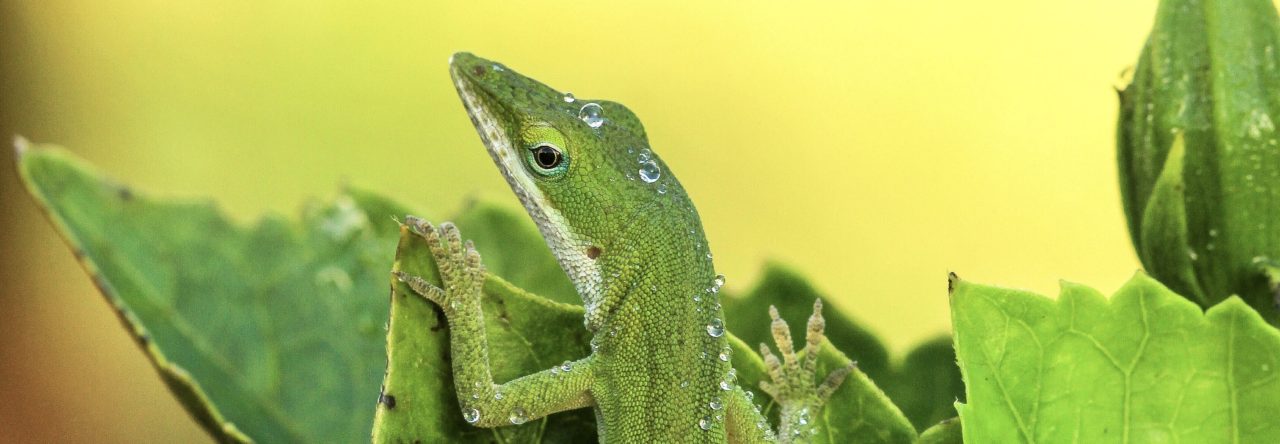
Image of the 1995 eruption of the Soufrière Hills volcano on Montserrat. Photo from Wikipedia.
On July 18, 1995 something big happened on a tiny little island in the Lesser Antilles. The Soufrière Hills volcano erupted on Montserrat, an island only about 40 square miles in size that is nestled between Nevis, Antigua, and Guadeloupe. The eruption buried the (then) capital city of Plymouth under several meters of ash and pyroclastic flow. More than a dozen nearby towns were also destroyed. Residents in the south of the island had to evacuate, leaving their homes and land behind. Since then, Montserrat has experienced considerable volcanic activity. In fact, when I was on the island in 2010, I witnessed a major dome collapse, an event that was magnificent to see on the ground, and was even observable from space. I’ve spent some time trying to find Anolis lividus, Montserrat’s endemic anole, across the island, with particular focus on finding it in the south, where volcanic impact has been greatest. Montserrat is basically divided in half by the Belham River Valley, a barren bed of ash that effectively separates the habitable north of the island from the more inhospitable south. I’ve spent many hours in the south of the island searching for A. lividus over a few years. In my experience, the lizards were not abundant (if to be found at all) south of the Belham. Granted, access to this region was very restricted, so I didn’t get to spend a whole lot of time there, but I only ever saw two lizards (a mating pair) on a tree in Richmond Hill, a part of the southern half that’s in Zone C. Towns in Zone C are close to the Belham River Valley and are occasionally opened up for visitors when the volcano has been quiet for a while. Currently, Zone C has ‘unrestricted access’, meaning people can visit day and night without an escort. There is also a relatively unexplored portion of Montserrat southeast of the volcano (the South Soufrière Hills) that has plenty of good habitat and is isolated by the rest of the island by the volcano. There have been a few focused expeditions to that part of the island (for example, to collect individuals of Leptodactylus fallax, the ‘mountain chicken’ frog, for a breeding program), but I haven’t been able to get there.
My interest in A. lividus lay mostly in understanding how recolonization works. Can the lizards cross the Belham River Valley, or is it too hot and inhospitable? As access to inner zones increases, will humans mediate transport into the south of the island? If they get there, will they persist? Although I haven’t been to the island in a few years, I remain very interested in the system. I recently received news on Anolis lividus from Nicolas Tirard, a new resident on the island. He had visited Zone C (which is currently open to daytime visitors) and found an individual of A. lividus. Nicolas informed me that he spotted the lizard (a male) on the terrace of an abandoned home in Richmond Hill, which is the same neighborhood where I found lizards almost six years earlier. Nicolas spent about 30 minutes canvassing this area and only found one lizard. For anyone with experience finding anoles in the Caribbean, particularly in the Lesser Antilles, we know that they are generally much more abundant than that. So I would reckon that lizards in Zone C are probably still pretty scant. I wonder if the lizard Nicolas did find descended from previous inhabitants in that area (for example, from the mating pair I observed earlier), or whether there have been more recent dispersal events. He went back on another occasion to St. George’s Hill, which he says is more densely forested than Richmond Hill, and saw three lizards there. When I visited St. George’s Hill a few years ago it was pretty barren, so clearly the habitat is recovering there.

Anolis lividus from Richmond Hill, Montserrat. Photo by Nicolas Tirard.
I asked Nicolas if he thought that humans were transporting the lizards (accidentally or otherwise) to Zone C through increased transit. Nicolas reckons the lizards can get there on their own right now. He says, “I don’t think it is a human-mediated recolonization, even if there is traffic going back and forth, because the vegetation has grown again in the Belham river, and it is probable that anole can now cross it by themselves.” The finding that the Belham is vegetated is interesting – during my visits there it was a hot, barren bed of ash. The only herps I saw there were enterprising iguanas, boldly basking on piles of hot ash. I also saw an iguana on the roof of a house once in Richmond Hill. As the exclusion zone becomes more accessible, I hope that people will try to find A. lividus (and other organisms) there and, hopefully, share their observations with the Anole Annals.
Nicholas shares his observations on his blog. He has also seen a blind snake (Typhlops) and several iguanas in the exclusion zone. Check out his blog for more.

Another image of the male Anolis lividus spotted in Richmond Hill. Photo by Nicolas Tirard.



















 On her own blog, Ambika Kamath explains that field work is often about surprises and unexpected mysteries. Check out
On her own blog, Ambika Kamath explains that field work is often about surprises and unexpected mysteries. Check out 
